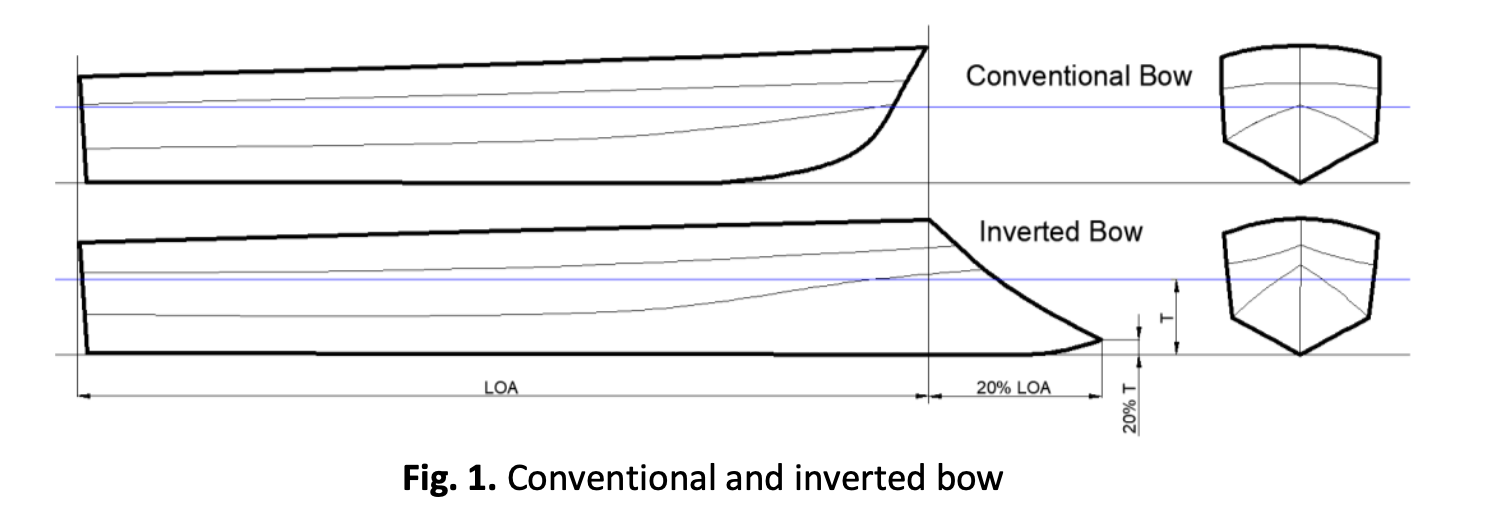CFD Analysis into the Resistance Estimation of Hard-Chine Monohull using Conventional against Inverted Bows
DOI:
https://doi.org/10.37934/cfdl.15.6.5464Keywords:
Resistance, conventional bow, inverted bow, hard-chine monohull, computational fluid dynamicsAbstract
There are many ways that ship designers can do to get the minimum engine power with the desire ship speed. One of the ways is to design the bow shape with the aim of minimizing ship resistance. In this study, the ship resistance of hard-chine monohull with two different bow shapes that conventional and inverted bows are analyzed. CFD (Computational Fluid Dynamics) approach by using Shear Stress Transport (SST) as turbulence model is used. Different ship speed by Froude numbers Fr 0.2 to 0.7 is applied. The simulation results give convincing evidence that the inverted bow produces lower total resistance compared to the conventional one by about 5% reduction
Downloads
References
Fitriadhy, Ahmad, Nurul Shukna Rizat, Atiyah Raihanah Abd Razak, Sheikh Fakhruradzi Abdullah, Faisal Mahmuddin, and Alamsyah Kurniawan. "Optimization Modelling of a Catamaran Hull Form towards Reducing Ship’s Total Resistance." CFD Letters 14, no. 4 (2022): 67-79. https://doi.org/10.37934/cfdl.14.4.6779
Lee, Soon-Sub, Jae-Chul Lee, Sung-Chul Shin, Soo-Young Kim, and Hyun-Sik Yoon. "A study on optimization of ship hull form based on neuro-response surface method (NRSM)." Journal of Marine Science and Technology 22, no. 6 (2014): 12.
Nazemian, Amin, and Parviz Ghadimi. "Global optimization of trimaran hull form to get minimum resistance by slender body method." Journal of the Brazilian Society of Mechanical Sciences and Engineering 43 (2021): 1-20. https://doi.org/10.1007/s40430-020-02791-8
Le, Trung-Kien, Ngo Van He, Ngo Van Hien, and Ngoc-Tam Bui. "Effects of a bulbous bow shape on added resistance acting on the hull of a ship in regular head wave." Journal of Marine Science and Engineering 9, no. 6 (2021): 559. https://doi.org/10.3390/jmse9060559
Utama, I. K. A. P., and I. K. Suastika. "Experimental and Numerical Investigation into the Effect of the Axe-Bow on the Drag Reduction of a Trimaran Configuration." International Journal of Technology 12, no. 3 (2021): 527-538. https://doi.org/10.14716/ijtech.v12i3.4659
Utama, I. Ketut Aria Pria. "CFD Analysis into the Drag Characteristics of Trimaran Vessel: Comparative Study between Standard NPL 4a and the use of Axe-Bow." In IOP Conference Series: Earth and Environmental Science, vol. 799, no. 1, p. 012007. IOP Publishing, 2021. https://doi.org/10.1088/1755-1315/799/1/012007
Luhulima, Richard Benny, Sutiyo Sutiyo, and I. Pria Utama. "The Resistance and EEDI Analysis of Trimaran Vessel with and without Axe-bow." NAŠE MORE: znanstveni časopis za more i pomorstvo 69, no. 3 (2022): 0-0. https://doi.org/10.17818/NM/2022/3.1
Su, Guangsheng, Hailong Shen, and Yumin Su. "Numerical prediction of hydrodynamic performance of planing trimaran with a wave-piercing bow." Journal of Marine Science and Engineering 8, no. 11 (2020): 897. https://doi.org/10.3390/jmse8110897
Philippe Goubault, Stephane Le Pallec, and Yann Floch. “Why Consider Inverted Bows on Militay Ships? Or why Not?.” Association Technique Maritime et Aéronautique (ATMA) 2018, no. 2729 (2018).
White, Jeffrey K., Stefano Brizzolara, and William Beaver. "Effect of Inverted Bow on the Hydrodynamic Performance of Navy Combatant Hull Forms." In SNAME Maritime Convention and 5th World Maritime Technology Conference. OnePetro, 2015. https://doi.org/10.5957/WMTC-2015-038
Nazemian, A., and P. Ghadimi. "Automated CFD-based optimization of inverted bow shape of a trimaran ship: An applicable and efficient optimization platform." Scientia Iranica 28, no. 5 B (2021): 2751-2768.
Compton, Roger H. "Resistance of a systematic series of semiplaning transom-stern hulls." Marine Technology and SNAME News 23, no. 04 (1986): 345-370. https://doi.org/10.5957/mt1.1986.23.4.345
Jabar, Siti Norbakyah, and Salisa Abdul Rahman. "A Comparative Study on Components Sizing for Conventional Boat and Pherb Powertrains using Water Driving Cycle." Journal of Advanced Research in Applied Sciences and Engineering Technology 16, no. 1 (2019): 41-48.
Waskito, Kurniawan Teguh. "On the High-Performance Hydrodynamics Design of a Trimaran Fishing Vessel." Journal of Advanced Research in Fluid Mechanics and Thermal Sciences 83, no. 1 (2021): 17-33. https://doi.org/10.37934/arfmts.83.1.1733
Utomo, Allessandro Setyo Anggito. "Comparison of Drag Reduction Effect on Barge Model Ship Using Ultrafine Bubble and Microbubble Injection." Journal of Advanced Research in Fluid Mechanics and Thermal Sciences 96, no. 2 (2022): 134-143. https://doi.org/10.37934/arfmts.96.2.134143
Ansys, C. "Ansys Cfx-Solver Modeling Guide. Canonsburg, PA, USA: ANSYS." (2020).
Anderson, John David, and John Wendt. Computational fluid dynamics. Vol. 206. New York: McGraw-Hill, 1995.
Menter, Florian R. "Elements of Inductrial Heat Tranfer Predictions." In 16th Brazilian Congress of Mechanical Engineering (COBEM), Uberlandia, Brazil, 2001. 2001.
Bardina, Jorge E., Peter G. Huang, and Thomas J. Coakley. Turbulence modeling validation, testing, and development. No. A-976276. 1997. https://doi.org/10.2514/6.1997-2121
Chung, T. Jꎬ. Computational fluid dynamics. Cambridge university press, 2002. https://doi.org/10.1017/CBO9780511606205
Zingg, D. "Viscous airfoil computations using Richardson extrapolation." In 10th Computational Fluid Dynamics Conference, p. 1559. 1991. https://doi.org/10.2514/6.1991-1559
ITTC. “CFD Verification.” ITTC – Recommendation Procedure Guideline. (1999): 485–487.





























